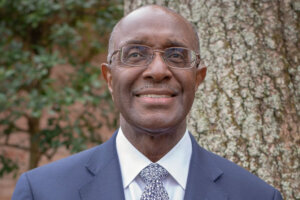
Virginia resident creates financial literacy programs for HBCU students
This is part of WTOP’s continuing coverage of people making a difference from our community authored by Stephanie Gaines-Bryant. Read more of that coverage.
More African Americans are graduating college than ever before, but the wealth gap between Black and white individuals persists.
Ted Daniels, president and CEO of Alexandria, Virginia-based Society for Financial Education and Professional Development, Inc., said the answer is to teach Black students financial literacy.
The organization, founded in 1998, provides financial literacy training to college students at HBCUs where many students are first-generation college students.
- More Local News
- Making a Difference
“We have the lowest credit scores of any group. Our percentage of investments is lower. The average balance in our 401(k)s is lower,” Daniels said.
Daniels said his program teaches students how credit scores work, the components of a credit score and how to manage a credit score. He said students are taught about stocks and mutual funds and how to use them to create wealth.

Daniels said in an interview with WTOP that financial literacy becomes a tool in time to create wealth, to build contentment and to have options in your life. But, he said, “If you don’t know the tools and how these personal money management concepts work, you can’t maximize the income generated from your degree.”
The organization also places emphasis on teaching students about homeownership.
“Only 42.3% of us own a home,” Daniels said. The organization teaches students about saving to put a down payment on a home and closing costs to build wealth for the next generation.
Daniels said they also offer a student ambassador program that teaches students the curriculum and, in turn, they teach it to their peers. He said he hopes students go back to their communities and share their knowledge with family and relatives.
He said students teach other students how to create budgets and managing credit card debt. The organization has continuing education for its students, which enables them to incorporate new lessons into the program, and it has an oversight professor to make sure the lessons are implemented properly.
He said students at schools like Howard University in Washington, D.C., and Morgan State University in Baltimore are encouraged to go out into the community to places such as local churches to teach the program.
Daniels said he has relationships with more than 70 HBCUs around the country and there are 31 student ambassador programs that go on at HBCUs year-round, but at one school the program is different.
Daniels said, “When you leave Hampton University, you’re going to know how to manage your money. Hampton’s program is different.”
Hampton is located in the Tidewater area of Virginia with a population of approximately 3,500 students. Its new president, Darrell Williams, has decided, Daniels said, that everyone on campus — including faculty, administrative staff and students — will receive financial literacy training.
The class will be mandatory for incoming freshman students. “We want Hampton to be the model that exists on all campuses.”
Daniels grew up in Atlanta, Georgia, and attended an HBCU, Fort Valley State University in Fort Valley, Georgia. He said he was recruited out of Fort Valley State to work for the U.S. Department of Housing and Urban Development where he said he was involved in establishing financial management during 28 of his 31 years with the agency.
He received his law degree at John Marshall University Law School in Atlanta. When he retired early, he said he wanted to use his knowledge of finance to help the African American community build generational wealth and founded the organization based in Alexandria, Virginia.
Source


